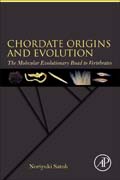
Chordate Origins and Evolution: The Molecular Evolutionary Road to Vertebrates
Satoh, Noriyuki
Chordate Origins and Evolution: The Molecular Evolutionary Road to Vertebrates focuses on echinoderms (starfish, sea urchins, and others), hemichordates (acorn worms, etc.), cephalochordates (lancelets), urochordates or tunicates (ascidians, larvaceans and others), and vertebrates. In general, evolution of these groups is discussed independently, on a larger scale: ambulacrarians (echi+hemi) and chordates (cephlo+uro+vert). Until now, discussion of these topics has been somewhat fragmented, and this work provides a unified presentation of the essential information. In the more than 150 years since Charles Darwin proposed the concept of the origin of species by means of natural selection, which has profoundly affected all fields of biology and medicine, the evolution of animals (metazoans) has been studied, discussed, and debated extensively. Following many decades of classical comparative morphology and embryology, the 1980s marked a turning point in studies of animal evolution, when molecular biological approaches, including molecular phylogeny (MP), molecular evolutionary developmental biology (evo-devo), and comparative genomics (CG), began to be employed. There are at least five key events in metazoan evolution, which include the origins of 1) diploblastic animals, such as cnidarians; 2) triploblastic animals or bilaterians; 3) protostomes and deuterostomes; 4) chordates, among deuterostomes; and 5) vertebrates, among chordates. The last two have received special attention in relation to evolution of human beings. During the past two decades, great advances have been made in this field, especially in regard to molecular and developmental mechanisms involved in the evolution of chordates. For example, the interpretation of phylogenetic relationships among deuterostomes has drastically changed. In addition, we have now obtained a large quantity of MP, evo-devo, and CG information on the origin and evolution of chordates. Covers the most significant advances in this field to give readers an understanding of the interesting biological issues involvedProvides a unified presentation of essential information regarding each phylum and an integrative understanding of molecular mechanisms involved in the origin and evolution of chordatesDiscusses the evolutionary scenario of chordates based on two major characteristic features of animals-namely modes of feeding (energy sources) and reproduction-as the two main forces driving animal evolution and benefiting dialogue for future studies of animal evolution INDICE: Chapter 1. Deuterostomes and chordates Chapter 2. Hypotheses on chordate origins Chapter 3. Fossil records Chapter 4. Molecular phylogeny Chapter 5. Comparative genomics of deuterostomes Chapter 6. The Origins of Chordates Chapter 7. The new organizers hypothesis for chordate origins Chapter 8. The DV-axis inversion hypothesis: the embryogenetic basis for the appearance of chordates Chapter 9. The enteropneust hypothesis and its interpretation Chapter 10. The evolution of chordates: an extension of the new organizers hypothesis Chapter 11. How did chordates originate and evolve? Chapter 12 Summary and perspective
- ISBN: 978-0-12-809934-6
- Editorial: Academic Press
- Encuadernacion: Rústica
- Páginas: 256
- Fecha Publicación: 01/08/2016
- Nº Volúmenes: 1
- Idioma: Inglés
